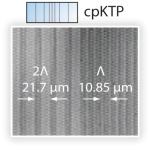Spectral bi-photon wave-packet shaping
- Post by: admin
- February 25, 2011
- No Comment
We have a new paper in Optics Express, “Engineered optical nonlinearity for quantum light sources“. We demonstrate a simple technique of longitudinal shaping of bi-photon wavepackets created via spontaneous parametric downconversion (SPDC).
In a standard SPDC experiment, wavepackets have a sinc frequency spectrum. This is due to the fact that a crystal has finite length and a rectangular shape—the nonlinear interaction between the pump beam and the crystal is thus turned on abruptly, to its full strength, when the pump enters the crystal, and remains constant until it is turned off to zero when the pump exits the crystal. In the frequency domain, this temporal step-function transforms into a sinc shape.
This spectral shape has a detrimental effect on the purity of the downconversion photons, as shown here. The purity determines the quality of two-photon interference between photons generated in independent SPDC sources. This, in turn, directly affects the performance of, e.g., photonic quantum gates.

In our paper, we solve this problem by longitudinally engineering the effective nonlinearity in a periodically poled KTPcrystal. We give the crystal a Gaussian nonlinearity profile by patterning it with discrete sections of increasingly higher-order polings. The pump beam which enters the crystal will first encounter a section with very high order poling, which effectively means it will experience a very weak nonlinearity. This effective nonlinearity then increases in discrete steps, peaks in the crystal center and then drops off symmetrically. We confirmed that our method works by measuring two-photon interference patterns, which are indeed Gaussian instead of triangular, which they normally are for sinc-shaped biphotons.
What surprised us was that, even though the crystal consists of dozens of section with different polings, the agreement of the measurements with our domain-by-domain theory predictions was excellent. In conclusion, the technique clearly works and has the big advantage that the usually hard work of spectral shaping is outsourced to the crystal manufacturer, who did an excellent job in our case.